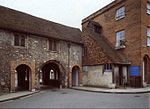Hospital of St Cross
1130s establishments in EnglandBuildings and structures completed in 1450Buildings and structures in WinchesterCharities based in HampshireEnglish medieval hospitals and almshouses ... and 6 more
Grade I listed almshousesGrade I listed buildings in HampshireHospitals established in the 12th centuryHospitals in HampshireTowers completed in the 15th centuryUse British English from July 2015

The Hospital of St Cross and Almshouse of Noble Poverty is a medieval almshouse in Winchester, Hampshire, England. It has been described as "England's oldest and most perfect almshouse". Most of the buildings and grounds are open to the public at certain times. It is a Grade I listed building.
Excerpt from the Wikipedia article Hospital of St Cross (License: CC BY-SA 3.0, Authors, Images).Hospital of St Cross
St Cross Hospital, Winchester St Cross
Geographical coordinates (GPS) Address Nearby Places Show on map
Geographical coordinates (GPS)
| Latitude | Longitude |
|---|---|
| N 51.048 ° | E -1.322 ° |
Address
Hospital of Saint Cross
St Cross Hospital
SO23 9RE Winchester, St Cross
England, United Kingdom
Open on Google Maps











